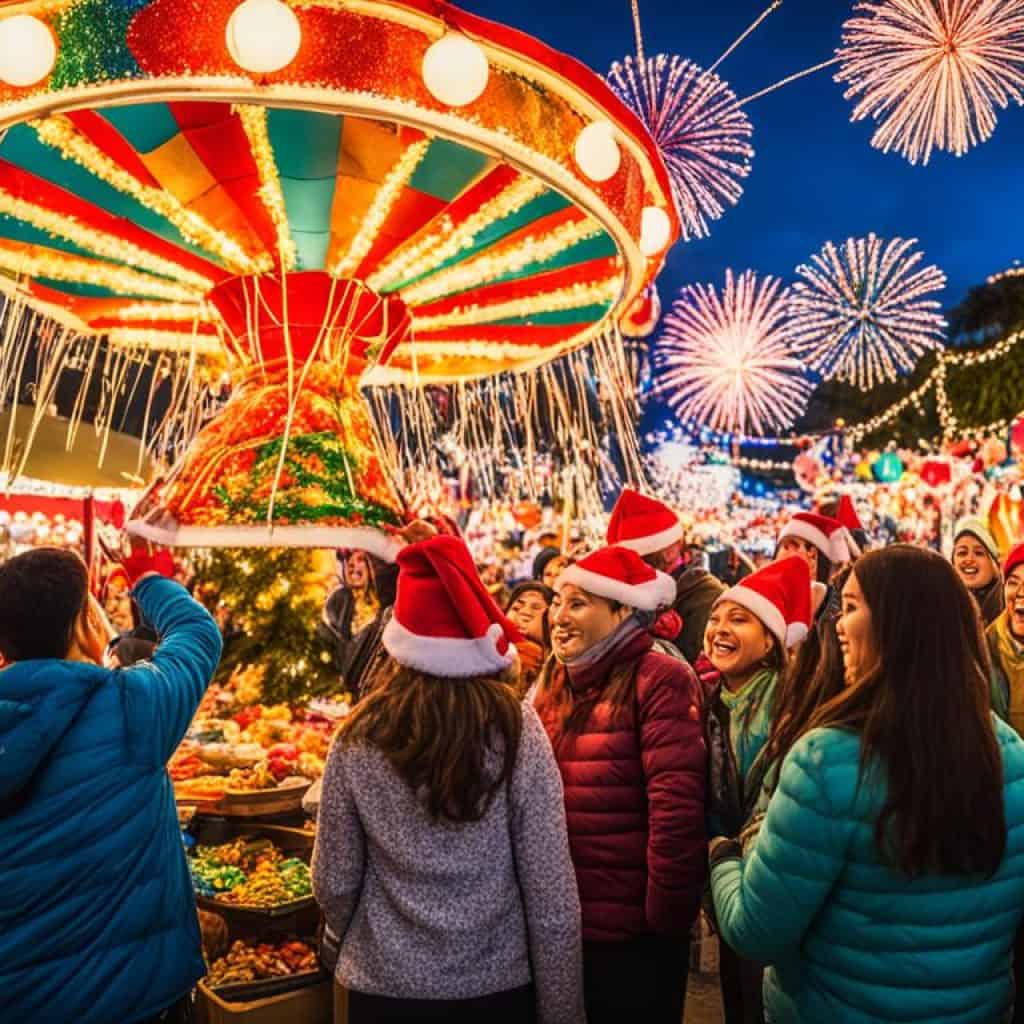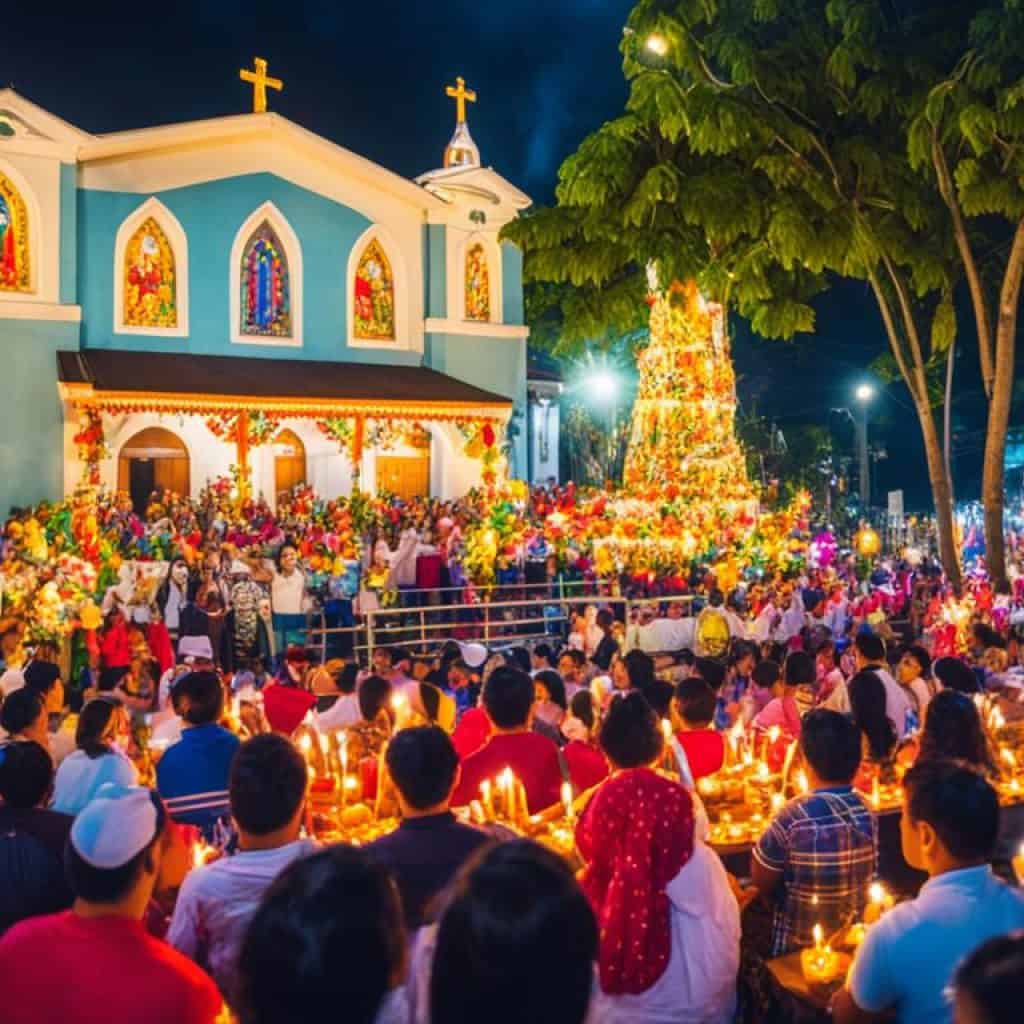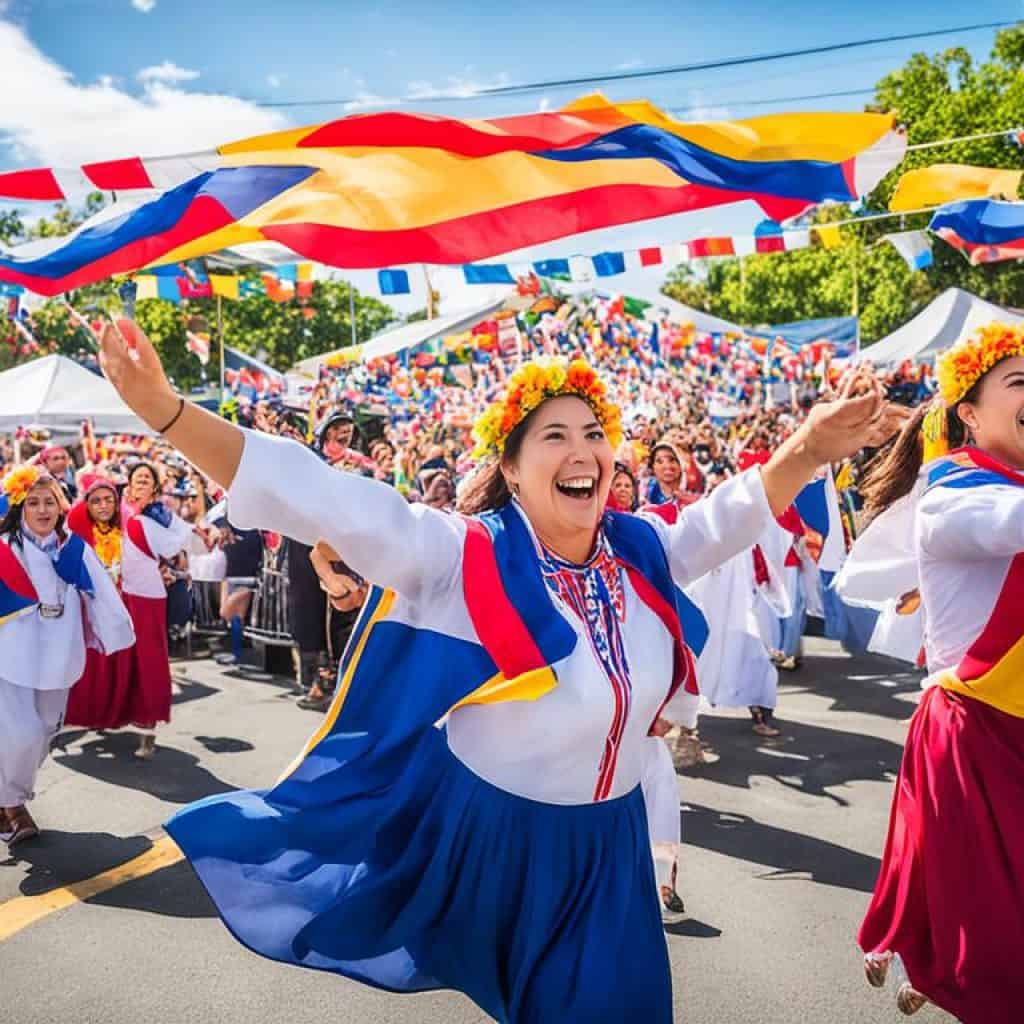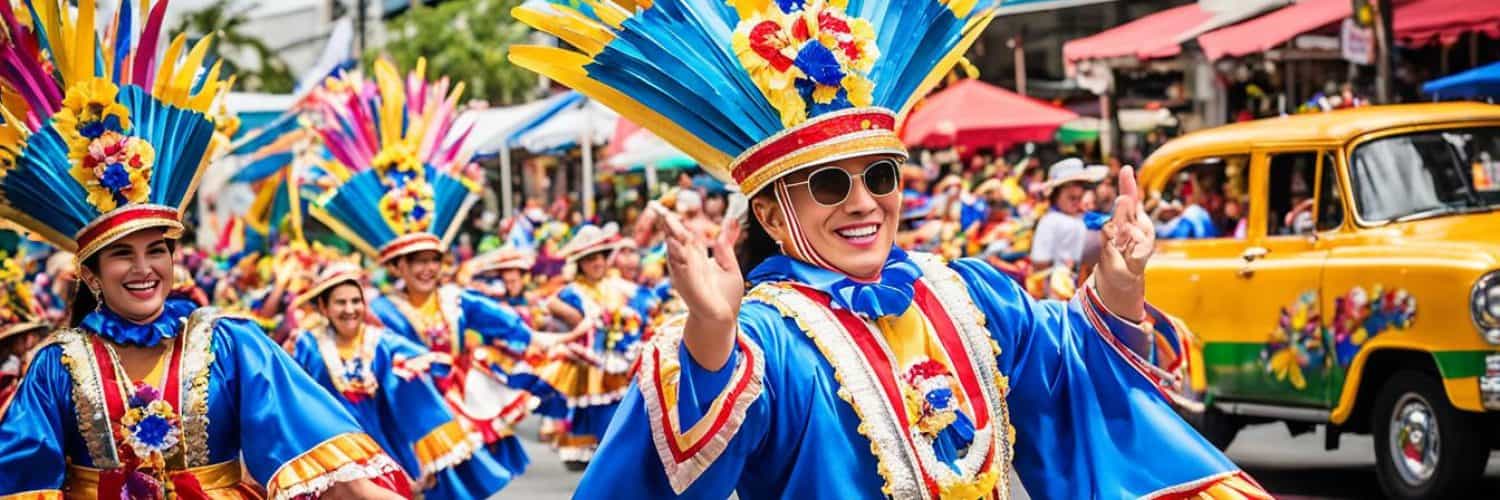Have you ever wondered what makes traditional Philippine fiestas so special? Why do they attract millions of visitors from around the world? Join us on a journey through the cultural celebrations in the Philippines, where centuries-old traditions come alive, creating a magical experience you won’t want to miss.
Key Takeaways:
- Traditional Philippine fiestas showcase the rich cultural heritage of different communities.
- Fiesta celebrations in the Philippines are usually religious in nature and associated with a patron saint.
- These festivals offer unique experiences for both local and international tourists.
- The Christmas season is the most-awaited and longest fiesta in the Philippines.
- Each Christmas decor used during the festivities has its own symbolic meaning.
The Most Popular Fiestas in the Philippines
Fiestas in the Philippines are vibrant and exciting celebrations that showcase the rich cultural heritage of the Filipino people. From religious processions to grand parades, these fiestas bring together communities to honor their patron saints and express their gratitude for bountiful harvests. Here are some of the most popular fiestas in the Philippines:
Sinulog
The Sinulog festival, held in Cebu City, is the most attended fiesta in the Philippines. It commemorates the feast of Santo Nino de Cebu, the patron saint of Cebu, and features a colorful street parade with participants dressed in vibrant costumes, dancing to the beat of the drums and chanting “Pit Señor!”
Kalibo Ati-Atihan
The Kalibo Ati-Atihan festival is another significant Santo Nino festival celebrated in Kalibo, Aklan. It is known for its lively street performances where participants, dressed as Atis or indigenous people, dance and chant to the rhythm of drums. This festival is a joyful display of unity and thanksgiving.
Pahiyas Fiesta
The Pahiyas fiesta in the town of Lukban, Quezon is a thanksgiving festival held in honor of San Isidro Labrador, the patron saint of farmers. During this fiesta, houses are adorned with colorful rice decorations such as kiping (rice wafers) and other agricultural products, creating a festive and visually stunning atmosphere.
Masskara Festival
The Masskara Festival, held annually in Bacolod City, was born out of resilience and the desire to uplift spirits during challenging times. It was originally celebrated to boost the morale of the people after the sugar crisis in 1980. The festival features street dances where participants wear vibrant masks or “masskara,” showcasing the resilience and optimism of the Bacolodnons.
Panagbenga Flower Festival
The Panagbenga Flower Festival is a month-long celebration held in Baguio City, known as the “Summer Capital of the Philippines.” This festival showcases a grand float parade adorned with colorful flowers, street dancing, and other exciting activities. It is a celebration of the city’s vibrant blooms and a tribute to the resilience of the people.
These popular fiestas in the Philippines are not only a celebration of faith and gratitude but also a testament to the Filipinos’ spirit of resilience, creativity, and unity. They offer visitors a unique opportunity to experience the vibrant culture and warm hospitality of the Filipino people.
The Excitement of the Christmas Season
The most-awaited, longest, and most exciting fiesta in the Philippines is the celebration of the Christmas season. The excitement starts as early as September when Christmas carols begin to play on the radio. Department stores start decorating with Christmas decors, and housewives start buying their Christmas gifts to avoid the rush. The spirit of the season creeps in, and by November 1, TV and radio hosts start their countdowns till Christmas day. Homes are decorated with Christmas trees, belens, and lanterns.

On Christmas eve, major TV stations gather their stars for performances, and at the stroke of midnight, families come together for the Noche Buena, a sumptuous dinner followed by gift-giving.
The Symbolism of Christmas Decors
Each Christmas decor holds a special meaning, representing significant symbols associated with the holiday season. From the beloved belen to the sparkling bells and the iconic Christmas tree, let’s explore the symbolism behind these cherished decorations that adorn Filipino homes and create a festive ambiance.
The Belen: A Symbol of the Birth of Jesus
The belen, a centerpiece in many Filipino households during Christmas, is a miniature replica of the manger where Baby Jesus was born. It depicts the holy scene, complete with figures representing Baby Jesus, his parents, Mary and Joseph, the Three Wise Men, shepherds, and animals. The belen reminds us of the joyful celebration of Jesus’ birth and the humble setting of his arrival.
Bells and Balls: Harmonious Announcements
Among the decorative elements adorning Christmas trees and homes, bells and balls hold a special significance. Bells are often associated with the announcement of a joyous occasion and signify the arrival of the Redeemer. Their enchanting sound fills the air, spreading the message of joy and hope. Similarly, the balls that adorn Christmas trees symbolize unity and the gathering of loved ones who come together to celebrate the holiday season.
The Lantern: Guiding Light and Festive Splendor
A notable symbol prominently seen during Filipino Christmas celebrations is the lantern, commonly known as the parol. Traditionally shaped like a star, the lantern illuminates the path to the manger, guiding the way for the faithful to honor the birth of Jesus. The parol’s vibrant colors and mesmerizing lights bring festive splendor to streets, buildings, and homes, captivating the hearts of all who behold its beauty.
The Christmas Tree: An Emblem of Generosity
Originating from Western traditions, the Christmas tree has become a beloved symbol of the holiday season worldwide. In the Filipino context, the Christmas tree represents the gifts brought by the Three Wise Men to honor Baby Jesus. It serves as a reminder of the spirit of generosity and the exchange of presents that mark this joyous time of the year. Families gather around the Christmas tree, joyfully sharing gifts and creating lasting memories.
The Simbang Gabi and Christmas Eve Tradition
One of the most cherished traditions during the Christmas season in the Philippines is the Simbang Gabi or dawn masses. Starting on December 16, churches across the country hold these special masses as a way for the faithful to prepare for the birth of Jesus on December 24, known as Christmas Eve.
The Simbang Gabi consists of nine consecutive days of daily novenas, with each mass held in the early hours of the morning. Despite the early hour, the faithful flock to churches in droves, eager to participate in this centuries-old tradition.
During the Simbang Gabi, the streets near the churches come alive with vendors selling a variety of Filipino rice delicacies. The aroma of puto bumbong, kutsinta, puto, and bibingka fills the air, enticing churchgoers to indulge in these delectable treats. These Filipino rice delicacies are traditionally enjoyed after attending the Simbang Gabi, adding to the joyous atmosphere of the Christmas season.
In addition to the religious aspect of the Simbang Gabi, Christmas eve in the Philippines is also marked by festive performances organized by major TV stations. These performances take place in open public spaces, allowing people to gather and enjoy the lively entertainment together. Singers, dancers, and other performers showcase their talents, spreading the Christmas cheer and adding to the excitement of the holiday season.
At midnight on Christmas Eve, families come together for the Noche Buena, a grand feast that brings loved ones closer. The table is filled with an array of sumptuous dishes, including traditional Filipino favorites such as lechon, ham, pancit, and various delicacies. The Noche Buena is not only a time for indulging in delicious food but also for sharing love, laughter, and precious moments with family and friends.

The Simbang Gabi and the Noche Buena are deeply rooted in Filipino culture and are cherished traditions that symbolize unity, faith, and the spirit of giving. These customs exemplify the warmth and hospitality of the Filipino people, making Christmas in the Philippines truly special and unforgettable.
New Year's Day Celebration
After the joyful celebration of Christmas day, Filipinos eagerly anticipate the arrival of New Year’s Day. This festive occasion is marked by great excitement and revelry, capturing the spirit of optimism and new beginnings.
Just like on Christmas eve, major TV stations across the Philippines organize performances featuring popular artists and celebrities. These lively shows create a joyful atmosphere, building anticipation for the countdown to the new year.
At the stroke of midnight, fireworks illuminate the night sky, filling it with brilliant bursts of color and enchantment. The breathtaking display of pyrotechnics is a sight to behold and sets the stage for the festivities to come.
Following the spectacle of fireworks, families and friends come together to enjoy a special late-night feast known as Media Noche. This sumptuous meal features an abundance of traditional Filipino dishes and delicacies, symbolizing prosperity and good fortune for the coming year.
Media Noche is a time for bonding and celebration, where loved ones share laughter, stories, and resolutions for the new year. It is a moment of joy and reflection as Filipinos bid farewell to the past and embrace the future with hope and optimism.
Special Events - Filipino Heritage Nights
Filipino Heritage Nights are special events held in different venues to celebrate Filipino culture and heritage. These events offer a unique opportunity for the Filipino community and its supporters to come together and showcase their rich traditions and vibrant cultural heritage. From lively cultural performances to mouthwatering traditional food, live music, and giveaways, these events are filled with excitement and festivities.
GS Warriors Filipino Heritage Night
The GS Warriors Filipino Heritage Night is a highly anticipated event that brings basketball and Filipino culture together. Fans of the Golden State Warriors gather at the Oracle Arena to cheer on their team while also celebrating their Filipino heritage. The night is filled with excitement, featuring cultural performances, special guest appearances, and Filipino-inspired halftime shows.
Westlake School for the Arts Nutcracker
The Westlake School for the Arts Nutcracker production is a spectacular showcase of Filipino talent and creativity. This annual event combines the timeless ballet classic with a Filipino twist, incorporating elements of Filipino culture into the performance. Audiences are treated to an enchanting display of dance, music, and storytelling, creating a truly magical experience.
Filipino American History Month Celebration
October is Filipino American History Month, and communities across the United States come together to celebrate and honor the contributions of Filipino Americans. Various events are organized nationwide, showcasing the achievements and rich cultural heritage of the Filipino American community. These celebrations often include art exhibits, cultural performances, educational seminars, and community gatherings.
Oakland A's Filipino Heritage Night
The Oakland A’s Filipino Heritage Night is a special event that unites baseball fans and the Filipino community. It’s a night of fun, food, and baseball, highlighting the shared love for both sports and Filipino culture. Fans are treated to cultural performances, Filipino-inspired food options, and exclusive merchandise, creating an unforgettable experience.
SF Giants Filipino Heritage Night
The SF Giants Filipino Heritage Night is a beloved tradition for San Francisco Giants fans and the Filipino community in the Bay Area. This event celebrates Filipino culture with vibrant cultural performances, traditional food offerings, and special audience interactions. It’s a night of unity and pride as the Filipino community comes together to support their favorite baseball team.
These Filipino Heritage Nights provide a platform to showcase the vibrant Filipino culture, build stronger community connections, and create lasting memories for all attendees. Whether you’re a sports fan, an art enthusiast, or simply interested in learning about Filipino heritage, these events offer something for everyone.

Coachella Valley Filipino Festival
The Coachella Valley Filipino Festival is an exciting event that celebrates the vibrant culture and rich heritage of the Filipino community in the Coachella Valley. This annual festival showcases a wide range of activities that cater to all ages and interests, making it a perfect destination for families and individuals alike.
One of the main highlights of the festival is the mouthwatering Filipino food that is available from various vendors. From classic favorites like adobo and pancit to delicious desserts like halo-halo, there is something to satisfy every palate. The festival provides a fantastic opportunity to indulge in authentic Filipino cuisine and savor the flavors of the Philippines.
In addition to the delectable food, the Coachella Valley Filipino Festival offers a vibrant lineup of live performances, showcasing traditional music and dance. Visitors can enjoy the energetic beats of tinikling and the graceful movements of the singkil dance. These performances provide a glimpse into the rich artistic traditions of the Philippines and captivate audiences with their beauty and precision.
The festival also features a cultural marketplace where attendees can explore and purchase Filipino crafts, artwork, and other cultural treasures. This marketplace is a hub of creativity, offering unique and meaningful souvenirs that reflect the art and culture of the Philippines. It is a perfect opportunity to support local artisans and take home a piece of Filipino heritage.
For art enthusiasts, the Coachella Valley Filipino Festival hosts art exhibitions that showcase the talent and creativity of Filipino artists. These exhibitions provide a platform for artists to express their unique perspectives and share their stories through various mediums. It’s a chance to immerse oneself in the vibrant art scene of the Filipino community.
Family-friendly activities are an integral part of the Coachella Valley Filipino Festival. The festival organizers understand the importance of creating a welcoming and inclusive environment for families to enjoy. From interactive workshops that teach traditional Filipino dances to games and activities for children, there is something for everyone to enjoy and participate in.
Admission to the Coachella Valley Filipino Festival is free, allowing everyone to experience the rich cultural heritage of the Philippines. Whether you’re a food enthusiast, art lover, or simply looking for a fun-filled day with your family, this festival offers an unforgettable experience that celebrates the beauty of Filipino culture.
| Highlights of the Coachella Valley Filipino Festival |
|---|
| Delicious Filipino food from various vendors |
| Live performances of traditional music and dance |
| A cultural marketplace showcasing Filipino crafts and artwork |
| Art exhibitions featuring Filipino artists |
| Family-friendly activities and workshops |
Conclusion
Fiesta in the Philippines is a vibrant celebration that beautifully showcases the diverse festivals and cultural traditions deeply rooted in Filipino heritage. These celebrations, ranging from religious fiestas to the joyous Christmas and New Year festivities, are eagerly embraced by Filipinos with immense joy and enthusiasm.
By participating in these fiestas, both local and international tourists can experience the unique vibrancy and colorful spirit of the Filipino people. The festivities offer a wonderful opportunity to immerse oneself in the rich tapestry of Philippine culture, providing a deeper understanding and appreciation for the traditions and values cherished by the Filipino community.
From the grand processions and mesmerizing performances to the mouthwatering culinary delights and captivating cultural showcases, each fiesta presents a captivating tapestry of the Filipino way of life. It is no wonder that these vibrant celebrations have become a highlight for travelers seeking an unforgettable experience filled with joy, warmth, and cultural significance.
So, whether you’re enchanted by the religious fervor exhibited during the Sinulog, captivated by the artistic brilliance of the Panagbenga Flower Festival, or simply seeking the festive Christmas cheer, the fiestas in the Philippines are sure to leave an indelible mark on your heart as you become a part of the rich Filipino cultural heritage.
FAQ
What are some of the most popular fiestas in the Philippines?
Some of the most popular fiestas in the Philippines include Sinulog, Kalibo Ati-Atihan, Pahiyas fiesta, Masskara Festival, and Panagbenga Flower Festival.
How do Filipinos celebrate the Christmas season?
Filipinos celebrate the Christmas season by playing Christmas carols, decorating their homes with Christmas decors, and having a special dinner called Noche Buena on Christmas eve.
What do the Christmas decors symbolize in the Philippines?
The belen symbolizes the manger where Baby Jesus was born, the bells and balls symbolize the coming of the Redeemer, the Christmas tree symbolizes the gifts brought by the three wise men, and the lantern symbolizes the guiding light to the manger.
What is the Simbang Gabi and Christmas Eve tradition in the Philippines?
The Simbang Gabi is a series of daily novenas held in churches leading up to December 24, and on Christmas eve, families come together for a sumptuous dinner called Noche Buena.
How is New Year’s Day celebrated in the Philippines?
New Year’s Day in the Philippines is celebrated with countdowns, fireworks, and a festive meal called Media Noche.
What are Filipino Heritage Nights?
Filipino Heritage Nights are special events that celebrate Filipino culture and heritage. They feature cultural performances, traditional food, live music, and giveaways.
What is the Coachella Valley Filipino Festival?
The Coachella Valley Filipino Festival is an event that celebrates Filipino culture and heritage in the Coachella Valley. It features food vendors, live performances of music and dance, cultural demonstrations, and family-friendly activities.


















Add comment